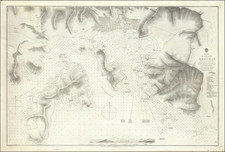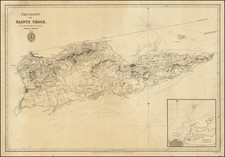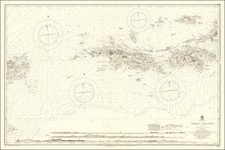Early British Sea Chart of Saint Croix
Detailed map of the Island of Saint Croix, published by the British Admiralty in 1831.
The British Admiralty chart of the Island of Saint Croix, published in 1831, provides an essential cartographic record of this part of the Virgin Islands during the early 19th century. This map draws its significance from its historical context, detailing an island that was pivotal in the larger framework of colonial geopolitics.
Historically, the accurate mapping of regions like the Virgin Islands held importance due to their strategic and economic value during the periods of colonial exploration and expansion. St. Croix, with its distinct geographical features and harbors, became a vital reference point for naval and merchant routes. Hence, the decision of the British Admiralty to commission such a chart during this time was consistent with these maritime interests.
A distinguishing feature of this 1831 chart is its reliance on the surveys of the Danish mariner General Peter Lotharius Oxholm, executed in 1799. Oxholm's survey stands as a significant contribution to the mapping of the region. This map was the second of its kind for St. Croix, offering a detailed and reliable representation of the island's topography.
Predating Oxholm's efforts was the work of I. M. Beck, who presented the island's subdivision into quarters and estates. Beck's map, titled "Tilforladelig Kort over Eylandet St. Croix" and engraved in Copenhagen in 1754, introduced this subdivision framework that would be referenced by many cartographers in the subsequent century.
The British Admiralty chart, influenced by both Oxholm and Beck's work, provides an objective depiction of St. Croix. Its importance lies not just in its representation of the island's physical features, but also in its embodiment of the methodical and precise approach to cartography during the 19th century. This chart is a testament to the evolution of map-making and the importance of St. Croix in maritime history.
The British Admiralty has produced nautical charts since 1795 under the auspices of the United Kingdom Hydrographic Office (HO). Its main task was to provide the Royal Navy with navigational products and service, but since 1821 it has also sold charts to the public.
In 1795, King George III appointed Alexander Dalrymple, a pedantic geographer, to consolidate, catalogue, and improve the Royal Navy’s charts. He produced the first chart as the Hydrographer to the Admiralty in 1802. Dalrymple, known for his sticky personality, served until his death in 1808, when he was succeeded by Captain Thomas Hurd. The HO has been run by naval officers ever since.
Hurd professionalized the office and increased its efficiency. He was succeeded by the Arctic explorer Captain William Parry in 1823. By 1825, the HO was offering over seven hundred charts and views for sale. Under Parry, the HO also began to participate in exploratory expeditions. The first was a joint French-Spanish-British trip to the South Atlantic, a voyage organized in part by the Royal Society of London.
In 1829, Rear-Admiral Sir Francis Beaufort was appointed Hydrographer Royal. Under his management, the HO introduced the wind force scale named for him, as well as began issuing official tide tables (1833). It was under Beaufort that HMS Beagle completed several surveying missions, including its most famous voyage commanded by Captain FitzRoy with Charles Darwin onboard. When Beaufort retired in 1855, the HO had nearly two thousand charts in its catalog.
Later in the nineteenth century, the HO supported the Challenger expedition, which is credited with helping to found the discipline of oceanography. The HO participated in the International Meridian Conference which decided on the Greenwich Meridian as the Prime Meridian. Regulation and standardization of oceanic and navigational measures continued into the twentieth century, with the HO participating at the first International Hydrographic Organization meeting in 1921.
During World War II, the HO chart making facility moved to Taunton, the first purpose-built building it ever inhabited. In 1953, the first purpose-built survey ship went to sea, the HMS Vidal. Today, there is an entire class of survey vessels that make up the Royal Navy’s Hydrographic Squadron. The HO began to computerize their charts in the late 1960s and early 1970s. In 1968, the compilation staff also came to Taunton, and the HO continues to work from there today.









![[ Virigin Islands to Trinidad and Tobago ] A Chart of the Antilles, or, Charibbee or, Caribs Islands, with the Virgin Isles . . . MDCCLXXXIV](https://storage.googleapis.com/raremaps/img/small/103660.jpg)
![[ Virgin Islands ] Anguilla to Porto Rico Shewing the Approaches to the Virgin Islands](https://storage.googleapis.com/raremaps/img/small/86323.jpg)

![[Puerto Rico and the Virgin Islands]](https://storage.googleapis.com/raremaps/img/small/82657.jpg)

